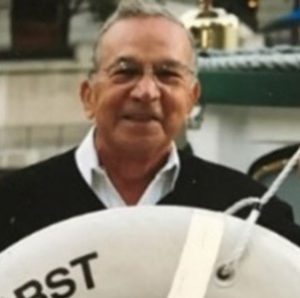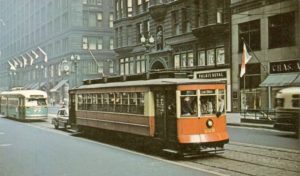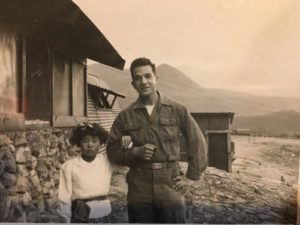
By Hy Speck, Class of 1995
I’ve been in love with Chicago since I was eight years old. For my eighth birthday my oldest brother, Oscar, took me downtown for lunch and a stage show. I had never been downtown before.
I was really excited! We boarded the big yellow and red street car at the corner. My brother gave me three cents to pay my own fare. Then I stood at the front of the car, next to the motorman, just in case he needed some help.

We got off at State and Randolph, the center of the theater district. I remember my child’s admission was only 11 cents. We found seats in the second row. I think the movie was “Hollywood Cavalcade” with Alice Faye and Don Amiche. The stage show was great! The Step Brothers, a tap-dancing quartet, then a pretty girl singer, and Carl Sands and his big band.
After the show we walked over to Wimpy’s Hamburgers, at Lake and Wabash, for lunch. It was my best birthday ever.

When I was 14, I got a summer job working for a family friend whose business was developing camera film for Walgreens. The lab was located on fourth floor of the 22-story Transportation Building, (600 S. Dearborn, Architect, Wm. Strepplemann). It now has been converted to condos.

My lunch hours were spent walking the Loop, admiring the tall buildings.
The following summer, I worked as a shipping clerk for a jeweler, (Gaines & Gaines) in the Kesner Building. (5 N. Wabash, Jenny, Mundie & Jensen, 1919). My last duty of the day was to take the mail to the main post office on Van Buren street. It was like entering a palace.
Unoccupied for over 20 years, the Post Office it is now a 23.3 million sq. ft. space, remodeled into condos, offices, and restaurants. It is spectacular.
After I graduated from Harrison High I enrolled at Herzl College, majoring in business. The Drama Department was staging the play “You Can’t Take It with You” and were desperate for actors. I was very reluctantly recruited to play the part of Tony Kirby, the romantic lead. Obviously type-casting. I got through it somehow. It was a great fun, and a very valuable experience.
Incidentally, each fall the school held a basketball free-throw contest. I won the contest, sinking 23 out of 25 baskets. I am proud to say that record has never been broken, because Herzl was closed the following year
That summer, 1953, I worked part-time after school at the telephone wire plant at Western Electric. It was there I first learned of the “Eastland Disaster.” On July 24, 1915, the Eastland tourist boat was chartered to take Western Electric employees on an outing across Lake Michigan to the Indiana Dunes State Park. The ship capsized at the dock at LaSalle Street and the river. Eight hundred forty four Western Electric employees and their families drowned. On my river tour, When we reach LaSalle Street on my river tour, I always tell the story of the tragedy of the Eastland.

November of 1953, the war was raging in Korea. I was drafted into the Army. After basic training, I was stationed at Ft. Belvoir in Virginia, just outside of Washington D.C. Almost every weekend we went into the city. We visited the White House, the Smithsonian, and the Capitol. Washington is a wonderful showcase for architecture.
Six months later, the war was still on, and we were shipped to Korea. Fortunately, when the North Koreans heard I was coming they threw down their arms and negotiated a peace treaty. I spent the next 13 months as the company clerk of the 76th Dump Truck Company of the 8th Army. Our company was stationed about 30 miles from the North Korean border.

I had the opportunity to visit Japan on R & R (Rest and Recuperation). We spent a week visiting Tokyo and Yokohama. The highlight was Frank Lloyd Wright’s Imperial Palace Hotel built in 1923. At the time I didn’t know who Frank Lloyd Wright was. I do now!

I was discharged in September 1953 and enrolled a Roosevelt University located in a building designed by Louis Sullivan and Dankmar Adler in 1889. I graduated with a degree in accounting in 1955. I worked as an accountant for two years, then decided accounting wasn’t for me. I decided to become a teacher in the Chicago Public Schools.

To be a certified teacher you must pass an exam. Unfortunately, my exam wasn’t being offered for another three years.
During that time I was a substitute teacher, filling in for a day or a month until the assigned instructor returned. At first it was very difficult. During those three years, I subbed in over 70 schools all over the city. After awhile, I became quite good at it and schools would ask for me. It was great experience.
My most memorable experience as a teacher was the day I was assigned to the Spalding School for Handicapped Children. As I entered the room, one of the little girls had her bare feet on top of her desk. I was about to say something when I caught myself. The little girl, eight year old Margaret Aubin ,was born with no arms. With a pencil between her toes, she was writing with her foot. Margaret, the daughter of a policeman, autographed this card for me. I’ve carried it with me ever since. She was a lovely young lady. I have never forgotten her smile.

Finally, my teaching exam was offered and I passed. I was assigned to Mather High School on the north side of Chicago. Mather was heaven. The school was brand new and the students were bright and fun.
One year when I didn’t get a summer school assignment, I worked as a relief janitor in an apartment building on Pearson and Seneca, across from the Museum of Cotemporary Art. On the 3rd floor of this building, lived the great Mies Mies van der Rohe. I never met him, but his housekeeper used to invite me up for lunch. I sat in that chair.
After three years at Mather, I was offered a promotion to the data processing department in the main office of the Chicago Board of Education. I would be teaching office employees how to use the new computer equipment. My office was on the 4th floor of the Builder’s Building. (228 N. LaSalle, Graham, Anderson, Probst & White) I had a lovely view of the tour boats sailing down the Chicago River.
One lunch time, I bought a ride on the 12:00 tour boat run by the Chicago Architecture Foundation. I had the most wonderful time viewing our gorgeous city from the river. I was hooked. I signed up to be a volunteer docent. Well, after eight weeks of Saturday classes, they said ”today you are a docent.” Twenty-five years of tours on the river, Millennium Park, and the architecture of the city, I’ve loved every minute of it.
After three years at the Board of Education, I was appointed to the to the position of professor in the new Data Processing Department at Harold Washington College at 30/64 E. Lake St. I taught there for 30 years and was chairman of the department for 17 of those years.
In the fall of of 1973, I taught the course “Introduction to Data Processing,” on television, Channel 11, WTTW. The course appeared twice a week for 16 weeks. I had students in the Chicago area and at several schools around the country. It also was used by the United States Army and Navy at several bases in Europe. This gave me the opportunity to visit my students in England and Germany and also view some of the great architecture in London and Paris.
One more story:
My wife and I have been blessed with two sons.
Son No. 1 is Mitchell Darrow Speck. Darrow is named after the great civil rights attorney, Clarence Darrow.
No. 2 son is Brian Gregory Joshua Speck, named after Gregory Peck, who won an Oscar for his portrayal of the lawyer Atticus Finch in the academy award winning movie “To Kill a Mocking Bird.” It struck me—Gregory Peck and Brian Speck.
Brian and his wife-to-be Juli were getting married at the top of Standard Oil Building, in the Mid-America Club. Designed by Edward Durrell Stone, it is 83 stories high and clad in Carrera marble. The wedding took place in one of the ballrooms, on the 83rd floor. The rooms are named after Frank Lloyd Wright, Louis Sullivan, and Mies van der Rohe. Can you believe it?
In a stroke of genius, I decided to invite Ms. Harper Lee, the author of “To Kill a Mocking Bird,” to the wedding. I sent her this invitation. The day before the wedding, we received this letter:
Well, that’s my story. I hope you enjoyed reading it as much as I did living it. My thanks to all my friends at CAC for making the journey so enjoyable and such smooth sailing.













What an amazing story! And so well told. Thank you for everything you have done for us, Hy.
What fun to reminisce with you,, Hy….you’ve had quite a JOYful journey…
Thanks for writing, Hy, and for all you’ve given to our community. What a fascinating saga!
You are a great storyteller and will be missed. Thanks for the wonderful trivia contests over the years. I always learned something new with each one. All the best.
I love the pictures and the Harper Lee letter. What experiences. Thanks, Hy.
Tom
Wow, thank you for sharing these incredible stories, I wonder what happened to “that chair”.
Only Hy could provide a biography via the buildings! You may take great photos, Hy, but you also paint great pictures with your words! Thank you for sharing all of this (and including those photos!).
Pris
This was wonderful. Thank you so much for sharing.
Delightful! Well done, Hy.
Hi Hy – what a great story! And being a retired IBMer, I understand the vast improvements in “Data Processing” since 1973. Times have changed, for sure.
Claudia
Hy, you are woven into the warp and woof of the CAF/CAC tapestry. What wonderful memories. Thanks for all the trivia — I played rarely, but read it always. The questions got us into facts we often didn’t know. And your life sounds so great. It’s so much fun to tell a life story in buildings, something only docents could do. Love you. Ellen
What a rollicking ride, Hy! Your story is fascinating, thanks to the word pictures you paint and the awesome photos you took to illustrate them. Thank you so much for sharing your stories with all of us. Having people like you in our peer group makes me very proud indeed to be a docent!.
What a wonderful story. Thank you for sharing. This really brightened my morning.
Thank you for this; such great stories. I wish we had a photo of you in Mies’ chair!
Wow. We all love Chicago Architecture, You lived it as well.
What a great story Hy! Thank you for sharing it with us and thank you for all you’ve been for docents and CAC!
I enjoyed reading your life story. I can relate. I was fascinated with occasional trips downtown as a kid. Also, my mother named me after Gregory Peck, too! I was born before the movie came out, so my mother didn’t have the excuse of naming me after the actor who portrayed a noble civil rights attorney. She just thought he was a good-looking man!
This was WONDERFUL ! I can only imagine how great your tours are, given the story-telling in this bio. It really makes me happy that I discovered the world of CAC docentry too. Thanks, Hy, for many terrific years of leading tours and being in the docent community.
Hy, this is the best, and YOU are the best. Such great stories and such a great memory of what’s important to CAC and in life.